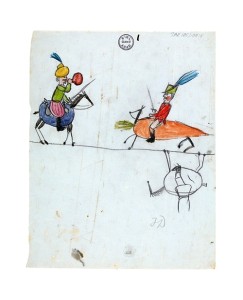This went up way back in February, but I just now discovered it: Darwin’s children doodled on his manuscript for Origin of Species. Via the great website The Appendix.

I love this! It’s adorable. Those little scamps! Darwin was a very good illustrator, as most naturalists needed to be in those days, and it looks like his large brood (ten children, although only seven survived to adulthood) took after him.
Although the drawings are (of course) unsigned, one of the perpetrators is thought to have been Francis Darwin, who grew up to become a naturalist himself.
That Appendix link shows several examples of the Darwin kids’ vandalism of the manuscript. Apparently only 28 pages of the original manuscript still survive. I wonder how many of the kids’ masterpieces are lost along with those other pages of Darwin’s magnum opus?
It also shows some of the kids’ scribblings in their mother Emma Darwin’s day-planner, which also has many quite competent drawings thought to have been made by Emma herself.
There’s a buried lede in this story: the children drew on their parents’ important papers, and Charles and Emma let them. Parents of the Victorian age are popularly imagined to be stern disciplinarians, bordering on sadistic, but these artifacts reveal the Darwins to be indulgent and good-humored with their kids, most of whom grew up to be quite accomplished, so they don’t seem to have suffered from this lenience.
Of course, the Darwins were wealthy, so their family was insulated from much of the harshness of the 19th century. They lived the life of leisurely country gentlefolk, on a sprawling estate with many servants.
Their butler, Joseph Parslow, also served as Charles’s assistant for many experiments he performed over the years to verify various aspects of his developing theory. I don’t know if history records what Parslow thought about these experiments, but they must have seemed outlandish to him. He shot partridges after heavy rains, for example, so Darwin could examine the mud in their feet and see if seeds were stuck to it. He and Charles also often played billiards. I’m certain there’s a great historical fiction to be written about this relationship, along the lines of P.G. Wodehouse’s Jeeves and Wooster stories.
I don’t like the typical portrayal of Charles Darwin in today’s culture, exemplified recently in the 2009 film Creation. He’s presented as a man consumed by existential angst over his agnosticism, fearful of the public backlash if he ever published his theory, heartbroken by the premature death of his favorite child, Annie, and wracked with pain from the never-diagnosed chronic illness that bothered him from middle age through the end of his life.
Emma is usually shown as a devoted, loving wife, but also a devout Anglican fretting for the survival of her husband’s soul.
That’s a woefully incomplete picture, unfair to the man and his family. I look at these kids’ drawings and I see a household full of play, love, invention, and adventure, where creativity was encouraged and prized and where easy humor was the order of the day. More people should be aware of this Charles Darwin.
